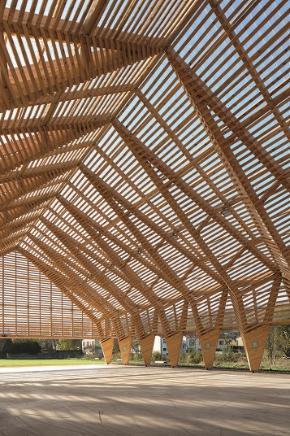Multipurpose hall in Ancy-Dornot, Moselle
Frugal architecture: 20 inspiring examples from the Grand Est
September 2021
FRUGALITÉ HEUREUSE et CREATIVE (FH&C)
There are already a large number of buildings that can be described as « frugal » and that demonstrate a new balance between tradition and modernity. This book highlights twenty projects recently built in the pioneering Grand Est region, whose local groups (in Lorraine and Alsace) are among the most committed. By sharing these inspiring examples, the intention of the Movement for Happy and Creative Frugality is to inspire professionals, decision-makers and citizens to get involved in the necessary paradigm shift, which is beginning to take shape.
Frugality in materials

The production of reinforced concrete is responsible for about 8% of CO2 emissions. As a large consumer of sand and aggregates, which are becoming increasingly rare, it should be reserved for structures for which it is essential: foundations, bridges, etc. For other structures, alternatives exist. For the others, alternatives exist. In the field of materials and their implementation, a frugal approach is guided by the use of local resources and the development of artisanal know-how. The reduction of the environmental footprint of the building is thus accompanied by the economic development of the surrounding area. The examples presented in this chapter prove that vernacular materials can serve modernity. Stone brings elegance and thermal inertia to the Audun-le-Roman health centre. Raw earth, compacted for the adobe walls of the archaeological heritage interpretation centre in Dehlingen, was « poured » between benches for the association house in Manom. The walls of the Achillée wine estate in Alsace are made of straw bales. As for wood, which is present in all the projects, it is used in small sections for the magnificent framework of the hall in Ancy-Dornot.
« This low-carbon project has strengthened the local economy: the black pine, cut from the forests of Ancy, was transformed into cladding boards in a nearby sawmill and the waste treated in the neighbouring village.
Paul de Rambures project carpenter
This spectacular wooden hall, designed like an origami, is the centrepiece of the new Fenottes leisure park. Despite its large volume, it fits delicately into its natural environment. Built in a flood zone, it is open on all four sides to allow the free flow of water in the event of flooding.

The programme is very clever in its versatility and frugality: for a third of the budget of an insulated and heated building, this 12 m high space can be adapted to multiple functions. Depending on the needs, it becomes a market hall, a festival hall, a marquee or a skate park. When its façades are covered with removable tarpaulins, the courtyard becomes an enclosed space that can host shows and the annual duck festival.
The primary structure is made of glued laminated Douglas fir, a species that is weather resistant without chemical treatment. The three-dimensional elements were prefabricated by the village carpentry company. In order to limit waste, the structure was designed to optimise the quantity of wood, metal and, above all, the polycarbonate roof surface, which allows natural light to pass through.

Technical specifications
Location: Ancy-Dornot, France
Year of construction: 2019
Surface area: 800 m2
Construction cost: 540.000 €
Owner: Municipality of Ancy-Dornot
Project management: Studiolada, Christophe Aubertin
Sources
To go further
The book « Architecture frugale: 20 inspiring examples in the Grand Est » is available in full (in French) on the website of the Happy and Creative Frugality Movement.